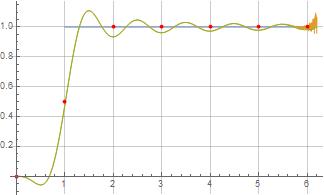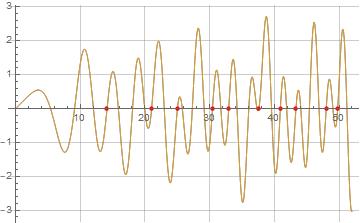Consider the summatory function $f_a(x)$ defined in formula (1) below where the related Dirichlet series $F_a(s)$ defined in formula (2) below converges for $\Re(s)\ge 2$.
$$f_a(x)=\sum\limits_{n=1}^x a(n)\tag{1}$$
$$F_a(s)=s\int\limits_0^\infty f_a(x)\,x^{-s-1}\,dx=\sum\limits_{n=1}^\infty a(n)\ n^{-s}\,,\quad\Re(s)\ge 2\tag{2}$$
In the remainder of this question $\tilde{f}_a(x)$ and $\tilde{f}_a'(x)$ are used to refer to analytic representations of $f_a(x)=\underset{\epsilon\to 0}{\text{lim}}\frac{f_a(x-\epsilon)+f_a(x+\epsilon)}{2}=\sum\limits_{n}a(n)\,\theta(x-n)$ and it's first-order derivative $f_a'(x)=\sum\limits_{n}a(n)\,\delta(x-n)$ where $\theta(x)$ is the Heaviside step function and $\delta(x)$ is the Dirac delta function.
I believe the conjectured analytic formulas defined in formulas (3) and (4) below, when evaluated at $f=1$, have the closed form representations defined in formulas (5) and (6) below for the case $a(n)=1$ where $F_a(s)=\zeta(s)$, and the closed form representations defined in formula (7) and (8) below for the case $a(n)=(-1)^{n-1}$ where $F_a(s)=\eta(s)$. The evaluation frequency $f$ in formulas (3) and (4) below is assumed to be a positive integer. I believe conjectured formulas (3) and (4) below are generally valid when $F_a(s)=\sum\limits_n \frac{a(n)}{n^s}$ converges for $\Re(s)\ge 2$.
$$\tilde{g}_a'(x)=\underset{\substack{K,f\to\infty \\ K\gg f\,x}}{\text{lim}}\left(-4 f\sum\limits_{k=2}^K x^k \sum\limits_{m=1}^{\frac{k}{2}-1}\frac{(2 \pi f i)^{k-2 m-2}\,F_a(2 m+2) }{(k-2 m-1)!}\right)\tag{3}$$
$$\tilde{f}_a'(x)=\underset{\substack{K,f\to\infty \\ K\gg f\,x}}{\text{lim}}\left(-4 f\sum\limits_{k=1}^K (-1)^k\ x^{2 k}\sum\limits_{j=1}^k \frac{(-1)^j\ (2 \pi f)^{2(k-j)}\ F_a(2 j)}{(2 k-2 j+1)!}\right)\tag{4}$$
$$\tag{5}\tilde{g}_a'(x)=2+\frac{\left(1-e^{2 i \pi x}\right) (1-i \pi x)}{\pi i x}\,,\quad f=1\land F_a(s)=\zeta(s)$$
$$\tilde{f}_a'(x)=\Re(\tilde{g}_a'(x))=1+\cos(2 \pi x)-\frac{\sin(2 \pi x)}{\pi x}\,,\quad f=1\land F_a(s)=\zeta(s)\tag{6}$$
$$\tilde{g}_a'(x)=-\frac{1-e^{2 i \pi x}}{\pi i x} -2 e^{i \pi x}\,,\quad f=1\land F_a(s)=\eta(s)\tag{7}$$
$$\tilde{f}_a'(x)=\Re\left(\tilde{g}_a'(x)\right)=\frac{\sin (2 \pi x)}{\pi x}-2 \cos (\pi x)\,,\quad f=1\land F_a(s)=\eta(s)\tag{8}$$
Formulas (3) and (4) above are based on this answer I posted to a related question on Math StackExchange and this answer I posted to my own question on MathOverflow. The closed form representations above are based on the following comment posted by user მამუკა ჯიბლაძე under my related Math StackExchange question. The comment below gives a closed form representation for $\tilde{a}(x)=\frac{1}{2}\tilde{g}_a'(x)|_{f=1}$ (where $\tilde{g}_a'(x)$ defined in formula (3) above is evaluated at $f=1$).
Yes, the coefficients sum up to $\frac{(2 \pi i)^k\ (k-1)}{2 (k+1)!}$ for $\zeta$ and to $\frac{(2 \pi i)^k \left(2^k-k-1\right)}{2^k (k+1)!}$ for $\eta$; accordingly, the series gives $1+\frac{\left(1-e^{2 i \pi x}\right) (1-i \pi x)}{2 \pi i x}$ for $\zeta$ and $-\frac{1-e^{2 i \pi x}}{2 \pi i x} -e^{i \pi x}$ for $\eta$
I verified the series coefficients for $\tilde{f}_a'(x)$ defined in formulas (6) and (8) above seem to match the series coefficients in formula (4) above for $\tilde{f}_a'(x)$ evaluated at $f=1$ for the cases $a(n)=1$ and $a(n)=(-1)^{n-1}$ where $F_a(s)=\zeta(s)$ and $F_a(s)=\eta(s)$. If the relationship $\tilde{f}_a'(x)=\Re(\tilde{g}_a'(x))$ continues to hold for $f>1$, then closed form representations for $\tilde{g}_a'(x)$ defined in formula (3) above for $f>1$ will lead to closed form representations for $\tilde{f}_a'(x)$ defined in formula (4) above for $f>1$.
I don't have a closed form representation of formulas (3) and (4) above for $\tilde{g}_a'(x)$ and $\tilde{f}_a'(x)$ evaluated at $f=1$ for the case $a(n)=\delta_{n-1}$ (Kronecker delta) where $F_a(s)=1$, but in this case formulas (3) and (4) above can be simplified to formulas (9) and (10) below.
$$\tilde{g}_a'(x)=\underset{\substack{K,f\to\infty \\ K\gg f\,x}}{\text{lim}}\left(-4 f\sum\limits_{k=2}^K x^k \sum\limits_{m=1}^{\frac{k}{2}-1}\frac{(2 \pi f i)^{k-2 m-2}}{(k-2 m-1)!}\right)\tag{9}$$
$$\tilde{f}_a'(x)=\underset{\substack{K,f\to\infty \\ K\gg f\,x}}{\text{lim}}\left(4 f \sum\limits_{k=1}^K x^{2 k} \sum\limits_{j=1}^k \frac{(-1)^j\ (2 \pi f)^{2 j-2}}{(2 j-1)!}\right)\tag{10}$$
Formulas (3) to (10) above are for the first-order derivatives $\tilde{g}_a'(x)$ and $\tilde{f}_a'(x)$. Corresponding formulas for $\tilde{g}_a(x)$ and $\tilde{f}_a(x)$ can be derived by integrating formulas (3) to (10) above, but I'll refrain from listing all of these formulas as I don't think they're necessary to answer my question and their derivation is fairly trivial. In this answer I posted to my own question on MathOverflow I defined the formula for $\tilde{f}_a(x)$ and illustrated it for a variety of arithmetic functions.
I mentioned the case $a(n)=\delta_{n-1}$ not only because it's the simplest possible case where $F_a(s)=1$, but also because the conjectured analytic formula defined in (11) below evaluates nearly identical to the analytic formula defined in (12) below. Since $f'(x)$ and $f(x)$ are even and odd functions, $f'(x)$ and $f(x)$ for the case $a(n)=\delta_{n-1}$ actually correspond to $\delta(x+1)+\delta(x-1)$ and $-1+\theta(x+1)+\theta(x-1)$, but in this question I'm focusing on evaluation in the right-half plane for $x\ge 0$.
$$\theta(x-1)=\underset{\substack{K,f\to\infty \\ K\gg f\,x}}{\text{lim}}\left(4 f \sum\limits_{k=1}^K \frac{x^{2 k+1}}{2 k+1} \sum\limits_{j=1}^k \frac{(-1)^j\ (2 \pi f)^{2 j-2}}{(2 j-1)!}\right)\,,\quad x\ge 0\tag{11}$$
$$\theta(x-1)=\underset{\substack{N,f\to\infty \\ M(N)=0}}{\text{lim}}\left(\sum\limits_{n=1}^N\mu(n)\left(\frac{x}{n}+\frac{1}{\pi}\sum\limits_{k=1}^{f\,n}\frac{\sin\left(\frac{2\pi k x}{n}\right)}{k}\right)\right)\,,\quad x\ge 0\tag{12}$$
This answer to one of my questions on MathOverflow proves $\underset{\substack{N\to\infty \\ M(N)=0}}{\text{lim}}\left(2\sum\limits_{n=1}^N\frac{\mu(n)}{n}\sum\limits_{k=1}^\infty\cos\left(\frac{2\pi k x}{n}\right)\right)=\delta(x+1)+\delta(x-1)$ which also implies $\underset{\substack{N\to\infty \\ M(N)=0}}{\text{lim}}\left(\frac{1}{\pi}\sum\limits_{n=1}^N\mu(n)\sum\limits_{k=1}^\infty\frac{\sin\left(\frac{2\pi k x}{n}\right)}{k}\right)=-1+\theta(x+1)+\theta(x-1)$. In formula (12) above, the evaluation limit $N$ must be selected such that $M(N)=0$ where $M(N)=\sum\limits_{n=1}^N \mu(n)$ is the Mertens function, and the inner sum over $k$ must be evaluated with the upper limit $f\,n$ in order to satisfy a conditional convergence requirement when formula (12) is evaluated at finite integer values of $f$. The $\frac{x}{n}$ term was included in formula (12) above to accelerate convergence, but this term can be dropped when $N\gg x$ since $\underset{N\to\infty}{\text{lim}}\left(\sum\limits_{n=1}^N\frac{\mu(n)}{n}\right)=0$.
Figures (1) to (4) below illustrate formulas (11) and (12) (orange and green) for $\theta(x-1)$ (blue) evaluated at $f=1$, $f=2$, $f=3$, and $f=4$. All four figures below were evaluated at the limits $K=200$ for formula (11) above and $N=101$ (which is the $7^{th}$ zero of Mertens function) for formula (12) above. Each time the evaluation frequency $f$ increases, the convergence range of formula (11) with respect to $x$ decreases, and therefore the evaluation in each figure below was terminated slightly after formula (11) started to diverge. Note in all four figures below, the evaluations of formulas (11) and (12) were nearly identical up to the point where formula (11) starts to diverge, and to me this seems to suggest an equivalence between formulas (11) and (12) above.
Figure (1): Illustration of formulas (11) and (12) (orange and green) for $\theta(x-1)$ (blue) evaluated at $f=1$
Figure (2): Illustration of formulas (11) and (12) (orange and green) for $\theta(x-1)$ (blue) evaluated at $f=2$
Figure (3): Illustration of formulas (11) and (12) (orange and green) for $\theta(x-1)$ (blue) evaluated at $f=3$
Figure (4): Illustration of formulas (11) and (12) (orange and green) for $\theta(x-1)$ (blue) evaluated at $f=4$
I tried adding the evaluation frequency $f$ in various places in the closed form representation defined in formula (6) above for the case $a(n)=1$ where $F_a(s)=\zeta(s)$ initially focusing on evaluation at $f=2$ illustrated in Figure (5) below (which was evaluated at $K=100$), but as I suspected the generalized closed form representation of formula (4) for integer values of $f$ greater than $1$ appears to be more complicated than a simple substitution in the closed form representation for $f=1$.
For the case $a(n)=1$ where $F_a(s)=\zeta(s)$, formula (4) above for $\tilde{f}a′(x)$ seems to evaluate to a Dirac comb with a tooth missing at $x=0$ which suggested the analytic formulas for $\delta(x)$ and $\theta(x)$ that were defined and illustrated in this answer I posted to my own question on MathOverflow.
Figure (5): Illustration of formula (4) for $\tilde{f}_a'(x)$ evaluated $f=2$ for the case $a(n)=1$ where $F_a(s)=\zeta(s)$
I suspect the closed form representation of formula (4) for $\tilde{f}_a'(x)$ as a function of $f$ gets increasingly more complex with more terms added each time $f$ increases, but perhaps the generalized closed form representation can be expressed as a finite sum.
Question: Can generalized closed form representations be derived for formulas (3) and (4) above for $\tilde{g}_a'(x)$ and $\tilde{f}_a'(x)$ when these formulas are evaluated at integer values of $f$ greater than $1$ for any of the cases $a(n)=1$, $a(n)=(-1)^{n-1}$, or $a(n)=\delta_{n-1}$ corresponding to $F_a(s)=\zeta(s)$, $F_a(s)=\eta(s)$, and $F_a(s)=1$?
Ideally I'd prefer a generalized closed form representation as a function of the evaluation frequency $f$ applicable to all positive integer values of $f$, but closed form representations for even a few integer values of $f$ greater than $f=1$ would be useful. A generalized closed form representation as a function of $f$ for one of the cases $a(n)=1$, $a(n)=(-1)^{n-1}$, or even $a(n)=\delta_{n-1}$ would perhaps lead to a proof or disproof of formula (4) for the specific case where the closed form representation can be derived. And if the closed form representation leads to a proof of formula (4) for the case $a(n)=1$ or $a(n)=(-1)^{n-1}$, then it could perhaps lead to a new formula for $\zeta(s)$ or $\eta(s)$.











